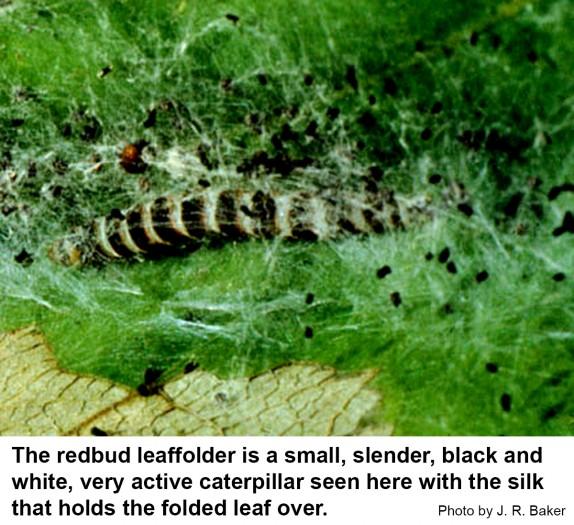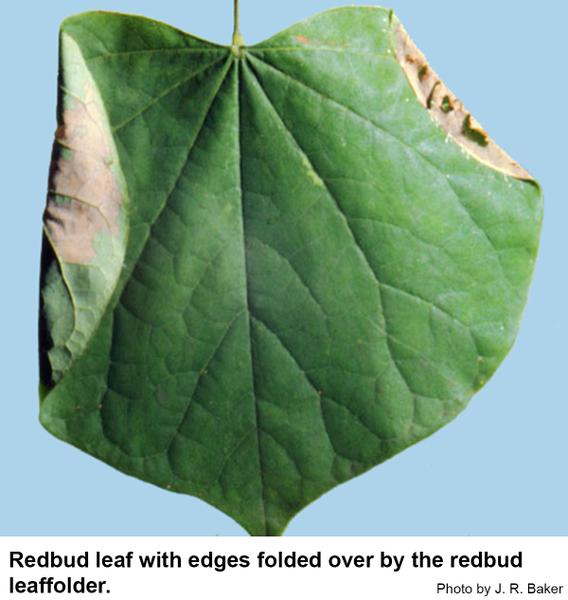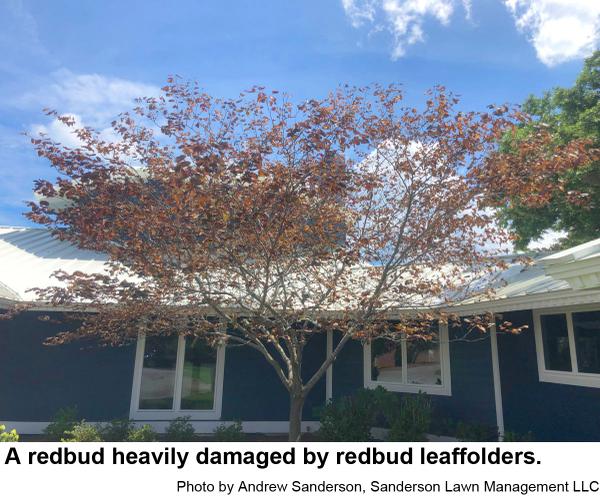Description and Biology
Not much has been published on the biology of the redbud leaffolder, Fascista Cercerisella. These small caterpillars apparently feed only on redbud.The ½-inch-long caterpillars are black with white markings and are extremely active when disturbed. They fold edges of leaves together or fasten two leaves together with strands of silk and feed within the shelter thus formed. When leaves are pulled apart, the worms usually go into a frenzy of thrashing about before dropping to the soil. There are two generations each summer. When mature, the leaffolders pupate within the shelter. The second generation of leaffolders overwinters as pupae in the fallen leaves. The adult is a small, black or very dark brown moth with white spots about ¼ inch long that first emerges in late April or early May. They lay their eggs near the veins. The second generation of eggs are laid in a thin web insided the folded shelter. The moths are also extremely active and run, jump and fly readily when disturbed.
Host Plant
Redbud, Cercis canadensis, is the only host for the redbud leaffolder. Infested trees are disfigured by dying leaves distorted by having the margin folded over. Heavily infested leaves drop prematurely.
Residential Recommendation
Because redbud leaffolders fasten the leaves together tightly, it may be best to use a systemic pesticide such as Orthene should control be necessary. Whatever pesticide is used should be sprayed on thoroughly to try to get in to soak into the shelters where the leaffolders are feeding. Another control strategy would be to apply a systemic insecticide such as imidacloprid to the soil under the tree in late winter. That would give the tree time to translocate the active ingredient up to the forming leaves. Both Orthene and imidacloprid are available in big box stores and garden centers. Imidacloprid is a Bayer product available in several formulations. Look for the active ingredient listed on the front of the package usually in very small font.
References
- 067925 – 2204 – Fascista cercerisella – Redbud Leaffolder Moth – (Chambers, 1872). Anon. No Date. North American Moth Photographers Group at the Mississippi Entomological Museum, Mississippi State U.
- Fascista cercerisella. Anon. 2013. Wikipedia, The Free Encyclopedia.
- Redbud Leaffolder, Fascista cercerisella. Anon. No Date. Information on Insects/Arthropods and Plant Diseases, Oklahoma State University Extension.
- Extension Plant Pathology Publications and Factsheets
- Horticultural Science Publications
- North Carolina Agricultural Chemicals Manual
For assistance with a specific problem, contact your local N.C. Cooperative Extension Center.
This Factsheet has not been peer reviewed.
Publication date: July 3, 2013
Reviewed/Revised: Oct. 11, 2019
Recommendations for the use of agricultural chemicals are included in this publication as a convenience to the reader. The use of brand names and any mention or listing of commercial products or services in this publication does not imply endorsement by NC State University or N.C. A&T State University nor discrimination against similar products or services not mentioned. Individuals who use agricultural chemicals are responsible for ensuring that the intended use complies with current regulations and conforms to the product label. Be sure to obtain current information about usage regulations and examine a current product label before applying any chemical. For assistance, contact your local N.C. Cooperative Extension county center.
N.C. Cooperative Extension prohibits discrimination and harassment regardless of age, color, disability, family and marital status, gender identity, national origin, political beliefs, race, religion, sex (including pregnancy), sexual orientation and veteran status.





